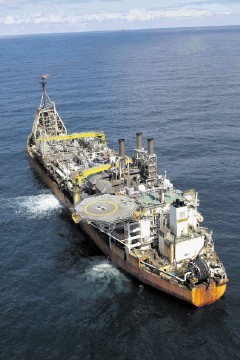
Dana Petroleum is on track to achieve board sanction for its £1billion ($1.6billion) North Sea Western Isles development this month and anticipated Government approval of the field development plan before the end of the year.
And, as of October 1, the company should be in a position to assume fully, its operatorship of the Triton field and production ship following a deal struck with Hess early this year to acquire its stake in the Bittern field and control of associated infrastructure.
North Sea MD, Paul Griffin, told Energy that Dana is on track with both projects, both of which are intended to contribute significantly to raising the company’s UK domestic output.
He said of Western Isles: “That is key to the UK and Dana’s growth over the next five years. We’re moving that towards a (Government) sanction decision towards the back end of this year, around November .
“We’re working very closely with our partners to move the project forward.”
Western Isles centres around two appraised discoveries called Harris and Barra, co-located in the North Sea, 160km east of Shetland and 12km west of the Tern field.
This is initially a nine-well subsea/production vessel development. There will be five production and four water injection wells, tied back to a new-build can-shaped (Sevan Marine) concept) floating production, storage and offloading vessel (FPSO) with oil export based on shuttle tankers.
Once sanction has been achieved, the major contracts will be formalised/placed, bearing in mind that Dana is already working closely with the Cosco yard in China, where the floater will be built.
Drilling is expected to begin late 2013 with subsea installation in summer 2014 and FPSO installation summer 2015, followed by first oil within the year.
The hope is that Western Isles will boost Dana’s production from the North Sea by at least 26,000 barrels oil equivalent per day. Expectation is that the FPSO will deliver around 40,000boepd gross to Dana (65%) and Cieco (35%).
Griffin explained that the company had opted for Cosco as the sole preferred bidder for the production unit.
“The entire vessel will be built in China . . . hull and topsides,” he said. “For me, the circular FPSO makes sense. It doesn’t need a mooring swivel or have to weathervane; it looks a good concept. It fits very nicely.”
Griffin said a great deal of time had been devoted to studying other FPSOs in a bid to get to their design pitfalls and operational issues, so that Dana could avoid repeating the mistakes of others.
“And we will unashamedly put people into the yard to look at every area of concern in great detail. This includes the quality and delivery of equipment, the quality of steel used by the yard, and the qualifications of those working on the key items.
“We know what others have done wrong; what I don’t want to do is to create a situation where something avoidable goes wrong in five year’s time.”
Turning to the Triton FPSO and the cluster of fields that it serves, Griffin said that everything possible had been done to assure a smooth transition, with October 1 set as the full handover date.
“A transition team has been working on it for the last six months, with a number of Hess people moving across though, effectively, the offshore site is run through a contract with Wood Group PSN.”
The current daily production from Bittern is 21,000boepd. Its pre-October share was 4.67% but has now climbed to 33%; and from all assets served by Triton (Bittern, Guillemot West, Guillemot North-West, Saxon, Clapham and Pict) it is 30,000boepd (gross)
Griffin explained that there were two primary reasons why Dana had decided to take control of Triton. One is to create a further North Sea business hub with scope for growth and the second is to learn about the operation of FPSOs so that an in-house capability can be developed.
“Its really important to understand that the real potential for Dana is bringing the FPSO operations within the company. Western Isles is an FPSO operation, Triton is an FPSO operation and we want to build a core competency in this type of operation.
“Bear in mind that, with Western Isles, we will build and own the FPSO within the group. Triton is a good model and it will provide pointers as to how we will operate Western Isles.
“Triton will bring about 5,000bpd incremental production initially. We already operate fields that tie-back. The only field that we won’t have direct day-to-day control over is Bittern, which is operated by Shell.
“Then we can look at other potential in the area. There are a number of opportunities. We have exploration and sub-surface teams looking through our entire portfolio, teasing out those opportunities.”
While there is little ullage in the Triton system at the moment, the situation will be different in five years when there will be capacity to accept tie-backs from new fields.
“You have to have a vision for the area. If the game-changer was just to take on the FPSO and run down the fields, I don’t think it would be good business.”
Recommended for you
